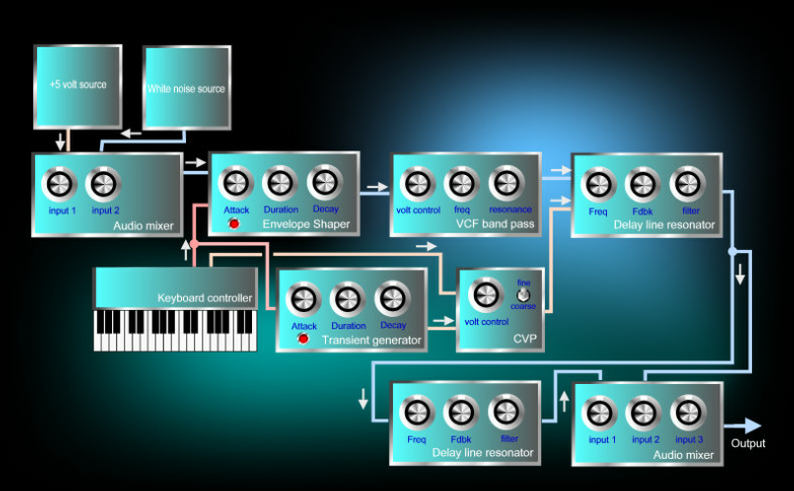
| Home | Previous page | Next page |
Acoustic Modelling 4.....
In the next patch below the basic string model (less body) is used but its output is treated by a circuit that partly models an important effect of the electronic pickup. The electronic pickup produces a highly coloured sound due partly to it only being able to pick up the string vibrations at just one point; obviously the location of the pickup. Since the harmonics of a plucked string have to vibrate at neat divisions of the string length (octave 1/2, fifth 1/3, octave 1/4 and so on) the pickup would have to be in just the right position to pick them all up equally. Stop the string at a fret and it all changes. For a harmonic that is neatly vibrating at some division of the string length that coincides with the pickup position, then the pickup will pick it up well. If it coincides with the points along the string where the harmonic is not vibrating (null point) it picks up nothing.
To create this effect, a series of certain fixed frequencies must be cancelled out. This is done electronically by spitting the signal from the string part into two, delaying one by a small fixed amount and mixing the two back together again. For those frequencies that happen to be delayed by exactly the time of one half a vibration, one of the signals will be vibrating one way while the other vibrates the opposite way. The re-mixed result is nothing at that frequency. The same will happen for higher harmonic multiples also, in fact, any case when the delayed signal ends up basically going the opposite way to the non delayed one. The series of cancellations is usually called comb filtering. The shorter delay, the nearer the ‘pickup’ is to the bridge.
In he patch the previous resonator is removed, by taking out the filter feeding the second delay line and turning the delay's internal feedback control to zero, so delay two is just the straight delay line. This is mixed with the direct signal from the first part of the patch..
To create this effect, a series of certain fixed frequencies must be cancelled out. This is done electronically by spitting the signal from the string part into two, delaying one by a small fixed amount and mixing the two back together again. For those frequencies that happen to be delayed by exactly the time of one half a vibration, one of the signals will be vibrating one way while the other vibrates the opposite way. The re-
This model does produce ‘electronic’ stringed instrument sounds. The most successful to date being a thoroughly convincing set of bass guitar sound models, complete with ‘moveable’ pickup positions.This is surprising as what it doesn’t model is the distortion produced by the vibrating string moving across the poles of the pickup and cutting the magnetic field at varying distances from it. This can be done and has been in models developed by other people.
BASS GUITAR MODEL...

Bass Guitar patch...
[SOUND EXAMPLE 3: Bass guitar... MP3 (128kbit/sec)] Bass guitar with variations in pick position and change of pickup position.
In the next pages two and more delay lines are added to the original basic string model to form various noise excited resonant arrays with some interesting results....
Using a modular analogue synthesiser